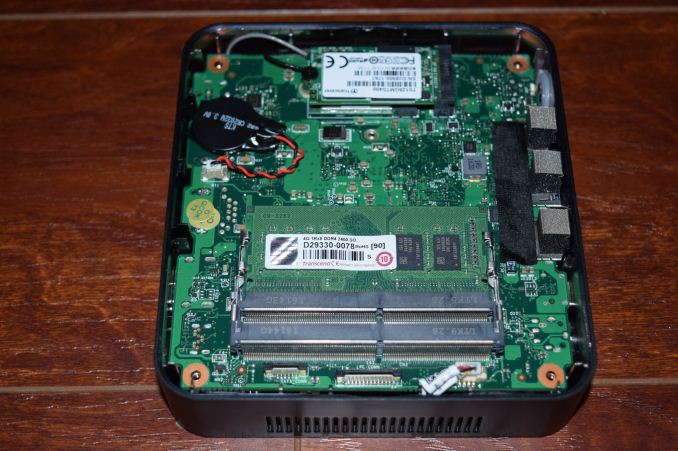ECS LIVA Z Plus Kaby Lake vPro UCFF PC Review
by Ganesh T S on April 12, 2017 8:00 AM ESTFinal Words
The ECS LIVA Z Plus provided us with the opportunity to take a first look at the performance of a vPro-capable mini-PC based on the Kaby Lake platform. Compared to the previous LIVA units, the Z family has moved on from providing systems with extremely small footprints. The boards are slightly larger than the traditional NUCs (115 x 111mm, as compared to 101.6 x 101.6mm). Fortunately, the larger footprint has enabled ECS to put in dual LAN ports in all the models. Dual LAN ports usually lend themselves to network appliances (x86 routers, firewalls, and the like). In the case of the Z Plus, one port is backed by an Intel I219-LM controller, while the other is backed by a Realtek controller. The presence of an Intel controller ensures good performance as well as wider compatibility for such use-cases. The WLAN interface is also of the premium variety, and the presence of three high-performance interfaces (2x GbE LAN and 1x 2x2 802.11ac WLAN) can lead to some interesting use-cases.
Even though the LIVA Z Plus fulfills all the basic necessities for a modern HTPC - 4K output (with 4Kp60 supported on the mini-DP port) and full hardware decode for 4Kp60 content in a variety of codecs - it is not a 4K OTT box because it lacks a HDCP 2.2-capable HDMI 2.0 port necessary for Netflix 4K (currently available only on select Kaby Lake systems). In any case, using a vPro-capable PC solely for HTPC purposes is an overkill. Systems such as the ASRock Beebox-S 7200U are a better fit for that purpose.
On the price front, the ECS LIVA Z Plus is a winner. $489 delivers a system ready for OS installation, which is a bargain for a system targeted towards business use-cases. The overall performance benefits and feature set are quite a step up from similarly priced Kaby Lake and Skylake systems. ME BIOS extensions allow the configuration of AMT features, and this is a boon to IT administrators.
The I/O and industrial design are pleasing to the eye. On the motherboard front, we would like to have support for the installation of a M.2 2280 SSD (currently, the choices for M.2 2242 SSDs supported by the LIVA Z Plus are limited). SATA SSDs are not going to create benchmark records, but, their performance is a good match for the typical LIVA Z Plus use-cases.
A 15W TDP CPU package would have severely stressed a fanless solution like that of the LIVA Z. However, ECS took the safe route here and integrated a fan to cool down the board's components. That said, we believe better thermal performance can be obtained by slightly altering the chassis design for better airflow.
The unit ships with only a single DDR4 SODIMM slot occupied. It would be an interesting exercise to determine if operation in dual-channel mode delivers any tangible performance benefits. Users can also install a second SODIMM - however, it is recommended that sticks from a dual SODIMM kit be used for this purpose.
One of the issues I encountered was related to HDMI signal stability under heavy load (such as Prime95) - Intrestingly, just replugging the HDMI cable solved the issue. ECS was able to recreate the issue at their end, and assured me that the final production kits with the latest Intel drivers would not exhibit the problem..
Coming to the business end of the review, we can say that, taken standalone, the ECS LIVA Z Plus more than delivers $489 worth of computing performance. It also manages to keep thermals under limit for consumer workloads. The idle and load power consumption profiles of the LIVA Z Plus are excellent and continue the tradition of the LIVA PCs being one of the most power-efficient lineups in the market. It is heartening to see vendors tackle the value segment in the vPro market.


















12 Comments
View All Comments
neo_1221 - Monday, May 15, 2017 - link
"Transcend TS128GMTS400 (512 GB)"I think you mean 128GB. Now I don't know if it's actually 20nm MLC or if that's a copy-paste error too...